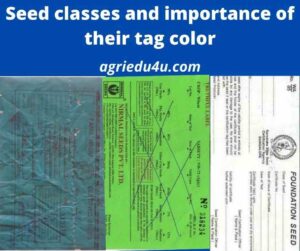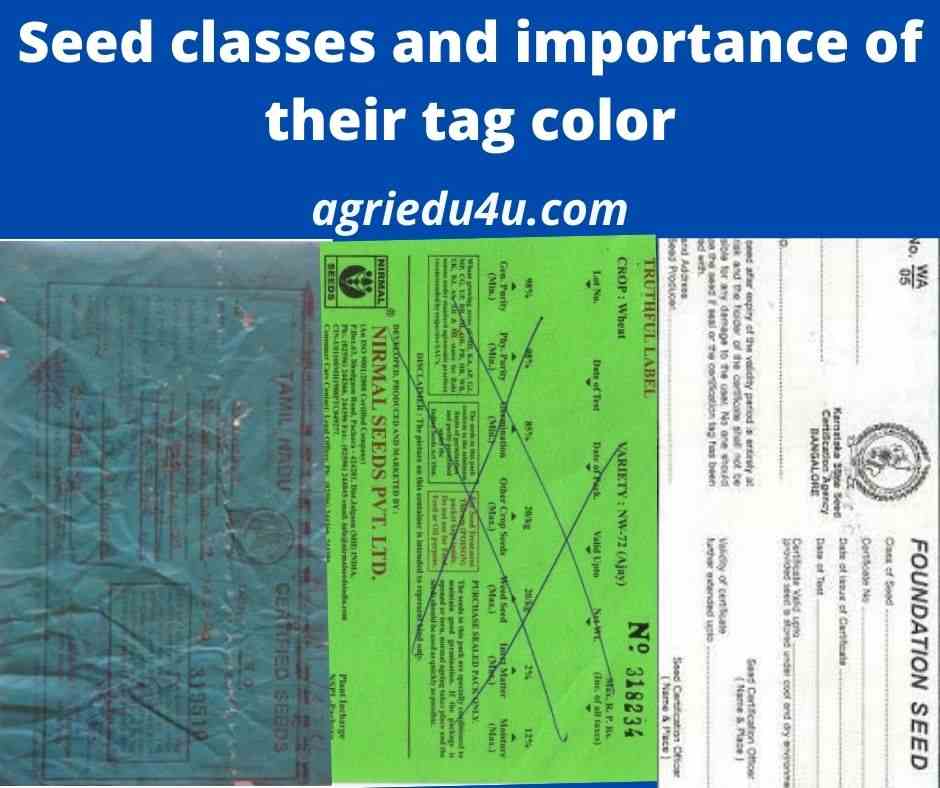
The various seed classes and importance of their tag color and are given below. Scroll down to see Table showing various seed classes and tag colors. The various Seed classes and importance of their tags are given below.
It is the hundred percent pure seed produced in low quantity under the direct supervision of breeder. The isolation distance has to be maintained properly to retain its purity. No tag color for nuclear seed.
Breeder seed
This seed class is the progeny of nucleus seed and is developed under supervision of breeder. It is produced in large quantity as compare to nucleus seed. It also provides cent per cent genetic and physical purity. A golden yellow colour tag with length of 12 cm and width of 6 cm is used for representation of these seeds.
Foundation seed
It is the progeny of nucleus or breeder seed handled by various public or private
seed producing agencies under the supervision of seed certifcation agency. These are purchased
by Seed Corporation from seed grower. A white colour tag is used for representation of these seeds. Foundation seed is also known as mother seed.
Certified seed
It is progeny of foundation seed and produced by registered seed growers under the supervision of seed certification agency by maintaining the seed quality as per minimum seed certifcation standards. These seeds are represented by blue colour tag.
Truthfully labeled seed
It is the progeny of either certified or registered seed produced under the supervision of farmers. An opal green tag with length of 15 cm and width of 10 cm is used for their representation. These are mainly produced by private companies.
Registered seed
It is progeny of foundation seed and produced by private growers in such a way that its genetic and physical purity are maintained to a great extent. The tag color of registered seeds is purple.
| Seed class | Tag color |
| Nucleus seed | No tag color |
| Breeder seed | Golden yellow |
| Foundation seed | White color |
| Certified seed | Blue color |
| Truthfully labelled seed | Opal green |
| Registered seed | Purple |
Seed classes and importance of their tags
Basics of seed science and seed classes and importance of their tags
Seeds wiki – Link
A seed is an embryonic plant enclosed in a protective outer covering. The formation of the seed is part of the process of reproduction in seed plants, the spermatophytes, including the gymnosperm and angiosperm plants.
Seeds are the product of the ripened ovule, after fertilization by pollen and some growth within the mother plant. The embryo develops from the zygote, and the seed coat from the integuments of the ovule.
Angiosperm (flowering plants) seeds consist of three genetically distinct constituents: (1) the embryo formed from the zygote, (2) the endosperm, which is normally triploid, (3) the seed coat from tissue derived from the maternal tissue of the ovule.
In angiosperms, the process of seed development begins with double fertilization, which involves the fusion of two male gametes with the egg cell and the central cell to form the primary endosperm and the zygote. Right after fertilization, the zygote is mostly inactive, but the primary endosperm divides rapidly to form the endosperm tissue. This tissue becomes the food the young plant will consume until the roots have developed after germination.
The maturing ovule undergoes marked changes in the integuments, generally a reduction and disorganization but occasionally a thickening. The seed coat forms from the two integuments or outer layers of cells of the ovule, which derive from tissue from the mother plant, the inner integument forms the tegmen and the outer forms the testa. (The seed coats of some monocotyledon plants, such as the grasses, are not distinct structures, but are fused with the fruit wall to form a pericarp.)
Other resources to help
Difference between seed classes link
Dehaulming in potato link

